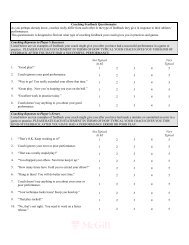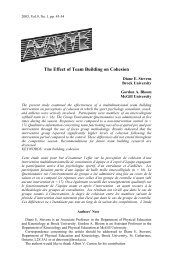International Journal of Sport Psychology
International Journal of Sport Psychology
International Journal of Sport Psychology
Create successful ePaper yourself
Turn your PDF publications into a flip-book with our unique Google optimized e-Paper software.
For the analysis <strong>of</strong> gaze patterns, we first selected those clips that were <strong>of</strong> average<br />
difficulty. To this end, a difficulty rating was calculated for each clip by dividing the number<br />
<strong>of</strong> saves by the number <strong>of</strong> participants. For each condition, eight video clips (i.e., a total <strong>of</strong><br />
sixteen clips) were selected nearest to the median difficulty rating for that condition. We chose<br />
to analyse clips <strong>of</strong> average difficulty because these videos are more likely to represent plays<br />
frequently encountered in real game situations. Next, a frame-by-frame analysis <strong>of</strong> the gaze<br />
pattern was performed for the selected film-clips. For each frame direction <strong>of</strong> gaze was<br />
categorized into 11 locations: ball, stick, ball-and-stick combination, stopper, upper- and<br />
lower-body <strong>of</strong> drag flicker, anticipated stopping location (i.e., area between stopper and drag<br />
flicker prior to ball arrival), area in front <strong>of</strong> the ball (i.e., when the ball was stopped),<br />
anticipated ball trajectory (i.e., fixating areas directly preceding the ball), overshoot (i.e., the<br />
gaze moves towards the stopping location, but shortly overshoots this location and, thus,<br />
requires a re-shift <strong>of</strong> gaze), and other. The latter condition was defined as all gaze directions<br />
that were not captured by the pre-defined 10 locations. The mean percentage <strong>of</strong> viewing time<br />
for each viewing location (i.e., ‘percentage viewing time’) was used as the gaze measure.<br />
DATA ANALYSIS<br />
First, we analysed the performance data. A paired t-test was used to compare the saving<br />
performances between the stationary viewing and the dynamic viewing conditions. In<br />
addition, Pearson correlations were performed to examine the relation between movement<br />
initiation time and saving performance.<br />
Second, gaze data were analysed by subjecting the percentage <strong>of</strong> viewing time to a 2<br />
(stationary vs. dynamic) by 11 (the respective viewing locations) ANOVA with repeated<br />
measures on both factors. Significant effects were further examined using t-tests as post hoc<br />
comparisons (Bonferroni-adjusted). In the case that post hoc comparisons indicated<br />
significant differences, we performed additional Pearson correlations to examine whether<br />
these differences were related to saving performance. Alpha level was set at 0.05 and effect<br />
sizes were calculated as partial eta squared values (ηp²).<br />
Results<br />
The performance score did not differ between the two viewing<br />
conditions (t(14) = .072, p > .10). Indeed, in the stationary viewing condition<br />
(73.33 %; SD = 22.09 %) the goalkeepers saved as many penalties as in the<br />
dynamic viewing condition (73.00%; SD = 27.44%). In addition, Pearson<br />
correlations indicated that goalkeepers who initiated their response<br />
movements later (i.e., waited longer) were more accurate in their decisions<br />
both in the stationary (r = .733, p < .01) and in the dynamic viewing<br />
condition (r = .816, p < .001). There was no significant difference for<br />
movement initiation times between the stationary (M = 179 ms; SD = 91 ms)<br />
and the dynamic viewing condition (M = 194 ms; SD =78 ms). With respect<br />
to percentage <strong>of</strong> viewing time ANOVA revealed a significant main effect for<br />
viewing location (F(10, 120) = 80.16, p < .001, ηp² = .87). There was no main<br />
334




